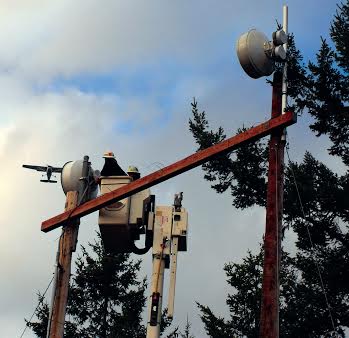— by Margie Doyle —

OPALCO line crew installs an additional microwave radio link as a part of the temporary emergency communication solution. OPALCO contributed photo.
A small rural electricity co-op came to the rescue when national telecommunications corporation giant CenturyLink was faced with disaster earlier this month.
Orcas Power & Light Cooperative (OPALCO) was at the ready to offer assistance — “in the spirit of of serving our members and helping a fellow utility,” according to OPALCO’s Communication Specialist Suzanne Olson — to CenturyLink as soon as the severity of the Tuesday Nov. 5 outage was discovered.
Under the immediate direction of Engineering and Operations Manager Russell Guerry, OPALCO was able to connect CenturyLink to the OPALCO data communications network to reroute critical 911 traffic, voice and then DSL (Internet) use. OPALCO did this by using the available capacity on its redundant fiber optic and microwave radio links on a temporary, emergency basis.
Olson says, “The quick and cooperative response was a result of relationships that have been cultivated between [OPALCO and CenturyLink] in the past year of discussions about sharing infrastructure to improve broadband services in San Juan County.”
CenturyLink provides emergency, telephone and internet services to San Juan County. The corporation responded quickly to repair the underwater cable when Brian Stading, CenturyLink’s Pacific Northwest regional president, learned of the issue early on Tuesday, Nov. 5 when he checked his email at work.
Even though it wasn’t an OPALCO cable, OPALCO was immediately impacted because their emergency power outage call center was disabled. After hours, emergency calls to OPALCO are routed through the Sheriff’s dispatch office.
When CenturyLink dispatched equipment and workers to locate and repair the broken link between Lopez and San Juan Islands, OPALCO was poised to provide backup.
Years of planning, with mapping, scheduling, maintenance, communications and systems updates by OPALCO, enabled its leadership and staff to respond so quickly and effectively to bring back communications interrupted by the undersea breakage. OPALCO helped CenturyLink “move” the transmissions from its underwater cable to OPALCO’s data communications network, utilizing a microwave radio link for the crossing between Lopez and San Juan Islands. OPALCO’s Olson emphasizes that the coop’s part in this emergency was to take over the transfer of 911 (emergency), voice (telephone) and data (Internet) messaging in a complex re-routing process. OPALCO was NOT involved in the actual physical location and repair of the cable break, as described by CenturyLink’s Stading in public meetings on Orcas and Lopez last week. OPALCO provided an alternate route to move CenturyLink’s data; it didn’t make repairs to the CenturyLink infrastructure. Once the CenturyLink connection was repaired, OPALCO switched the transmission connections back.
“We had the available capacity through our rendundant fiber and microwave links to handle CenturyLink’s basic needs as a temporary emergency solution,” said Guerry ; “However, we would be challenged to carry all CenturyLink’s DSL service on our redundant circuit.”
Still, “It was a big work effort,” said Russell Guerry, with notable understatement. Olson adds, “We have the staff expertise to solve big problems — whether or not the person is standing in the room with you — we’re a great team and we work well together.”
Rick Lysen, OPALCO’s network engineer for its fiber optic system Island Network, was the mastermind who configured the emergency transmission systems, involving systems’ capacity, routes, and timing. Lysen is the technical network designer who originally designed OPALCO’s fiber optic system. From his network operations center in Bellingham, he monitors OPALCO’s network continuously.
When he first learned of the CenturyLink break on Tuesday, Nov. 5, Lysen was on the road. He was on the phone with CenturyLink as he traveled back to the office and spent hours communicating with them about “what we at OPALCO could do and then how to get a temporary solution while CenturyLink’s fiber cable was being repaired.
“I wish it was only 24/7 that we were working,” Lysen says. “It was more like 36/7.”
He worked with the technicians on the islands until the wee hours that night, putting together a plan to cross-connect the coop’s system with CenturyLink’s. (OPALCO’s network never went down, and so its team was able to communicate via telephone and skype. )
In the field, OPALCO line crews from Lopez, San Juan and Orcas islands installed equipment, including new poles so communication solutions could be deployed. “The whole line crew pulled out all the stops in a very efficient manner,” said Olson.
By Wednesday evening, Lysen says, “We were able to hand over the circuits to support 911 emergency traffic.”
Crucial to the repairs was David Harold, who had the painstaking work of splicing fiber cables ) OPALCO crews installed a “fairly robust” microwave radio link, using point-to-point antenna (visually much like the “facing-saucer” configuration of satellite dishes.) These antennae projected a narrow bandwidth for focused transmission. “It’s a pretty sturdy way to move concentrated traffic,” said Guerry. “You can push a lot more data when broadcast areas are focused.”
OPALCO had submarine cables suffer downage in the early 1990s in roughly the same location – where a sharp underwater pinnacle creates a hazard – located 5,100 feet from the Lopez shore ( a YouTube recounting of the event can be found at www.opalco.com/history ).
Since purchasing and installing fiber optic capability in 2001, OPALCO has implemented a complete circuit or circular loop of telecommunications from both Bellingham (microwave radio) and Anacortes (submarine cable) throughout the islands. This provided the redundancy that enabled OPALCO to step up to restore emergency telecommunications services.
As recently as last August, OPALCO installed the Lopez-San Juan microwave radio to further build OPALCO redundancy and capabilities
Ironically, OPALCO had scheduled a second project, to install another radio link “identical to the location and data capacity” of the CenturyLink breakage, for the first week in November. (That project has now been completed). Olson notes that staff from the County Department of Emergency Management, the Sheriff’s Office and the Fire Department worked together to make sure our island residents had good information about where to call for emergency assistance.
Since its founding in 1937, OPALCO, under the direction of its members and its board, has anticipated and met the needs for reliable and safe power (now including communications) to the county. The 10-day emergency prompted by CenturyLink’s cable break brought to life some important considerations for moving forward:
1) OPALCO, as a power company, is a “first responder” in emergencies;
2) Although OPALCO has regularly planned emergency trials, this disaster gives immediacy to the need to revisit practices, protocols, resources and contacts;
3) Islanders’ personal need and demand for a complex communications infrastructure demands that OPALCO continue to find ways to make the member-owned infrastructure available to all.
Rick Lysen said from his Bellingham office after the 10-day interruption was mostly resolved, “The whole CenturyLink outage was a tremendous challenge for our network with OPALCO. I for one am very pleased with how we were able to respond.”
OPALCO’s Data Communications Network
• 69.9 circuit miles of fiber optic cable owned
• 14 microwaves covering 6 wireless paths (32 miles covered via wireless)
• 17 transmission submarine and substation connections
• 19 distribution automation connections
OPALCO’s Island Network
• Island Network is a division of OPALCO that delivers data communications services to 28 institutional and commercial members.
• Island Network was founded in 2000 after OPALCO installed a fiber network to serve our own internal and field communication needs.
• Once OPALCO’s needs were met, leadership decided to make additional capacity available to public institutions, first, and then commercial entities.
• Island Network members pay the cost to connect to OPALCO’s network and a monthly subscription fee. In some cases, the initial cost to connect was embedded into monthly subscription rates.
• There is currently a moratorium on new Island Network connections until a review of subscriber rates, policies and design is complete to the extent that cost in aid of construction (CIAC) can be estimated.
• A new position, Manager of Information Services, has been created to manage Island Network going forward. John Graminski will take that position beginning in February of 2014.
**If you are reading theOrcasonian for free, thank your fellow islanders. If you would like to support theOrcasonian CLICK HERE to set your modestly-priced, voluntary subscription. Otherwise, no worries; we’re happy to share with you.**








Great work, Margie! I’m sending this to our legislature and some larger media outlets.
Great write-up, Margie. Thanks.
Ditto Peg and MOana. Bravo!
OPALCO comes out as the shining example of a local utility that plans for and takes care of its members! Without OPALCO, we’d be warming up the carrier pigeons right now!
Basic 911 telephone service is a “safety of life” issue, quite different from offering bandwidth for entertainment. Its what you expect a true utility to do. A short while ago, this county debated OPALCO’s involvement in becoming the backbone for essential communications. Some asked, could they, really, a co-op, when the crunch came? Life happens, and now we know who is prepared and able to deliver essential service and who is not. Thanks OPALCO.
Will OPALCO be reimbursed by CenturyLink for any and all expenses incurred by the broken cable? I hope so. Thank you again OPALCO for everything you do each and every day.